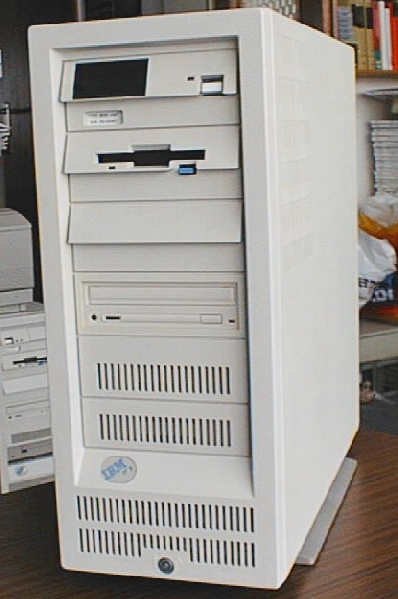
Click here or click onto the photo for a full size version of this picture.
Another example of the 8595 machines that were upgraded to 9595 systems: In contrast to the larger 9595 systems (labeled as 'Server 95(A)'), they did not obtain the newer planar with additional ports and faster bus cycles; the major enhancement is a graphics board that allows to run high-resolution graphics at flicker-free refresh rates (that's why these machines have a blue IBM badge at the front, opposed to the grey/silver one of the older 8595 systems).
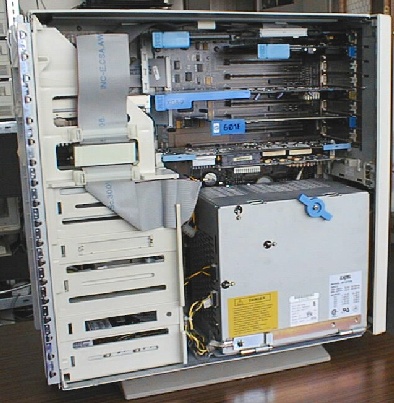
Click here or click onto the photo
for a full size version of this picture.
Since nothing serious changed in the outer appearance, the innards also do not differ much. Space in abundance is available for drives, you could put in two full-height 5,25 inch hard disks and still have space for a CD-ROM, the floppy and an additional 3,5 inch device. 8 32-bit-slots are provided, but one of them is always occupied by the video card (the 95 system planar does not have on-board video), ant the topmost one is typically filled with IBM cache-based SCSI controller (codenamed 'Spock'). Cable clips are provided to cleany lead the SCSI cable to the drive bays, and a huge ferrite block helps against EMI. Generally, PS/2 systems are quiet 'silent' in electromagentical terms...
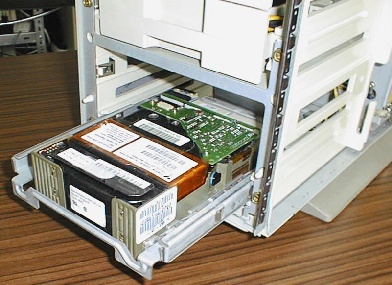
Click here or click onto the photo
for a full size version of this picture.
The 'T' in the full designation '9595-AMT' describes the 1GByte hard disk. It is an IBM 0663, member of IBM's first generation of hard disks with MR heads. They are a quite unconventional construction, with a HDA so large that the electronics had to be 'built around' the HDA: the motor drivers are sitting on a flex print located in the front corners, and the main electronics is plit in 5 PCBs, stacked in four layers. No fun to disassemble... Furthermore, the HDA case has to be isolated from electrical ground. These properties soonly gave the 066x drives a reputation of being unreliable, and in fact they are a bit sensitive. Nevetheless, this drive is still in working condition after almost a decade.
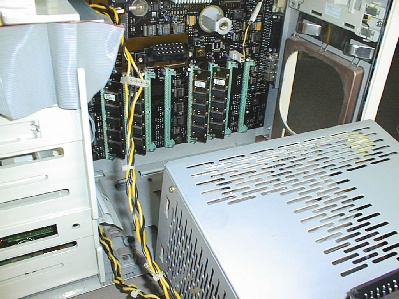
Click here or click onto the photo
for a full size version of this picture.
Starting with the Type 3 complex, Models 90 and 95 support ECC memory, i.e. memory modules of 40 instead of 36 bits width. The additional bits allow to correct individual bit errors on-the-fly and to detect any double bit error. However, theses modules are quite rare and expensive, so it is improbable that this machine will be someday upgraded to more than 16MB...
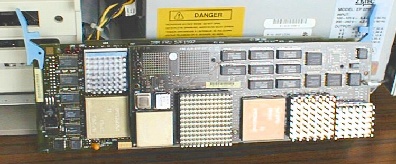
Click here or click onto the photo
for a full size version of this picture.
The Type 3 processor complex features an i486DX50 processor with 256 Kbytes external L2 cache, giving quite a nice performance boost compared to the L2-cacheless DX2/50 on its Type 2 predecessor. The design of a processor board with 50 MHz external clock was however a non-trivial task at that time, and the Intel cache controller placed severe constraints on the maximum trace length between cache controller, CPU, and the L2 cache RAMs. This and the amount of chips needed for the whole design forced IBM to stack two PCBs onto each other, with the CPU and core logic on the 'first floor'. This however creates problems when using a Type 3 complex in a Model 90 with its limitations in space...
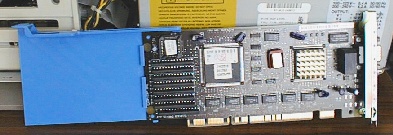
Click here or click onto the photo
for a full size version of this picture.
The XGA-2 graphics board was IBM's first graphics card that was halfway competitive; it offered both high resolutions with more than 8bpp and eye-friendly refresh rates. This is the earlier revision of the XGA-2 that is slightly limited in the capabilities of its DAC; later DACs have a white ceramic plate instead of the heatsink on the DAC and can be driven well up to 80 MHz pixel clock. If only IBM had provided an upgrade option to 2 MByte VRAM...

Click here or click onto the photo
for a full size version of this picture.
Almost standard equipment for a PS/2 machine: IBM favoured Token Ring to Ethernet in those days, and one of these 16/4 Mbit adapters can be found in almost all PS/2s that were used in a networked environment. Token Ring is well supported by Linux, the driver is just a bit sensitive to broken rings and misconfigured other parties in the ring :-)
- Processor:
- Intel i486DX @ 50 MHz
- Coprocessor:
- integrated into CPU
- Cache:
- 8K internally in CPU, 256K external L2 cache
- Memory:
- 16 Mbytes (options range from 8M to 64M)
- Bus:
- 8 MCA slots (32 bit)
- Interfaces (onboard):
-
- Mouse, Keyboard
- 1 x Serial
- 1 x Parallel
- Floppy (2.88M), allows attachment of up to 3(!) drives
- Add-on cards:
-
- IBM 16/4 Token Ring Adapter
- IBM XGA-2 Graphics Adapter
- IBM SCSI Controller with Cache(2M)
- Hewlett-Packard Adapter for Scanjet+
- Operating System(s):
-
- Caldera OpenDOS 7.01
- OS/3 Warp 3
- Linux 2.2 (Slackware-based)
- Useful Links: